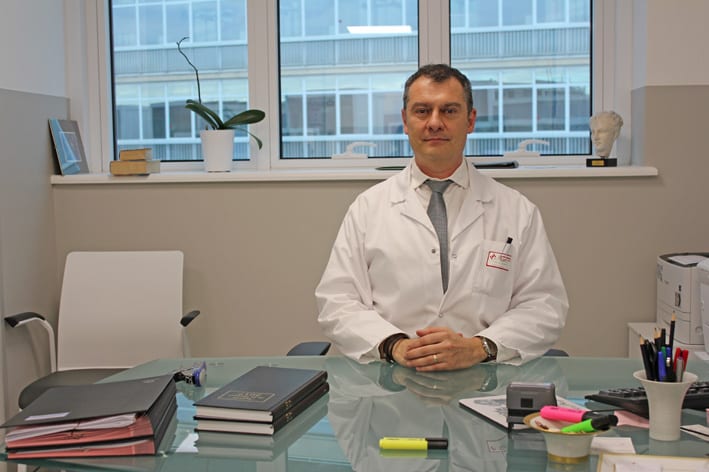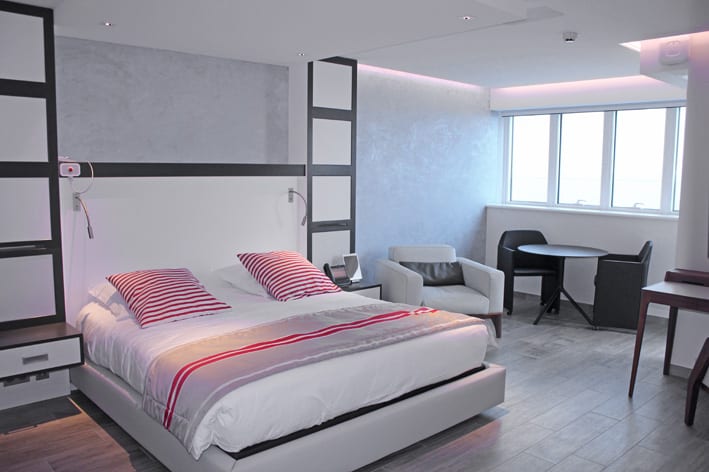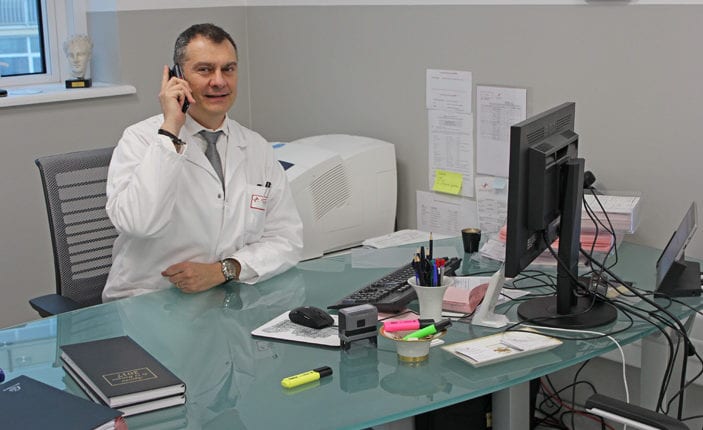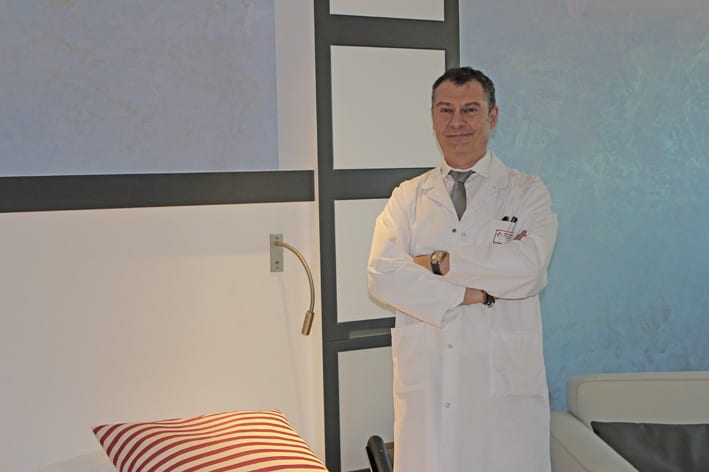
I first heard about the Monaco Princess Grace Check-up Unit (MPGCU), a medical service that opened on February 29, 2016, from Stéphane Valeri, Minister of Health and Social Affairs. “We have three luxury suites, some amazing technical equipment at the hospital and high quality, multilingual medical staff. In the first months after opening, we received as many local patients as foreign coming for a checkup.”
The decision to create the examination centre came from the CSA, Monaco’s Strategic Council for Attractiveness (Conseil Stratégique pour l’Attractivité), to communicate to both residents and visitors that Monaco has a one-stop complete health care facility, including emergency care and all the specialist departments at the Princess Grace Hospital (Centre Hospitalier Princesse Grace, or CHPG), as well as a high level and affordable check-up unit, where English is a given among the multilingual staff.
Multiple tests in one luxury location
The MPGCU’s medical coordinator, Dr Gilles Chironi, is a specialist who came from the Assistance Publique – Hôpitaux de Paris, and is, in fact, Monegasque. “Like many Monegasques, I studied in France. First Lyon and then got my qualification in cardiology from Paris, where I became involved in cardiovascular prevention, looking into risk factors like hypertension, hypercholesterolemia and diabetes and detecting early alterations of arteries and heart in order to prevent their evolution.”
As a university doctor in Paris, Dr Chironi gained experience in building checkups dedicated to prevention. He, naturally, maintained contact with his family’s hospital in Monaco, the CHPG, and remained in touch with Minister Valeri and Mr Patrick Bini, Director at CHPG, who were interested in his profile as they were planning to open a Five-star luxury check-up unit. “I was already trained in performing cardiovascular checkups but here I have the opportunity to make multidisciplinary exams and coordinate with the other 21 hospital specialists, including oncology, gynaecology, urology, gastroenterology and so forth.”
The CHPG has all divisions except cardiovascular and brain surgery, which are done respectively at their partnered Cardiothoracic Center of Monaco on avenue d’Ostende, and the University Hospital of Nice.
To be clear, the MPGCU is not like a monothematic “hôpital de jour” (day hospital) you would find in France where are reimbursed by French Social Security.
“The idea is to build a dedicated itinerary, with a combination of multidisciplinary tests within a single block of time and in one single location,” explains Dr Chironi. “A place with luxury suites that also provides security and where anonymity, a major factor for many patients, is ensured.”
Visitors to the MPGCU don’t seem to mind that these tests are not reimbursed by the CCSS, Monaco’s Social Security.
Since the check-up unit officially opened on the top two floors of an ultra-modern building at the Princess Grace Hospital last year, there have been two types of patients: foreign Monaco residents and people from abroad, mainly Russia. “We’ve had patients from Moscow or St Petersburg, for example, for a general checkup or looking for a second opinion, like one patient with a suspicious stomach ulcer looking for a diagnosis other than that of her doctors in Russia. She’s coming here next week,” Dr Chironi shares. “We’ve also had patients from the Gulf States, Saudi Arabia, Lebanon, as well as from Europe – Germany, the UK and Switzerland.”
The US has a very different health care system. Are Americans checking in? “Not yet. The US has prestigious universities like the Mayo Clinic, if you can afford them. Americans have faith in their health care, and they are right, obviously, with their very high levels of medicine. However, our unit and hospital obviously offer the same standards of medical care, based on international up-to-date recommendations. And we are in close relationship with the University of Pennsylvania –Princess Grace was born in Philadelphia – by exchanging doctors’ trainings, discussing complex medical cases and sharing expertises.”
Potential outpatients can be reassured that the MPGCU’s prices are not as high as similar services in Europe and the US. “When we build the check-up schedule, including not only imaging but also consultations and blood tests, we estimate the price and announce this to the patient,” clarifies Dr Chironi. This fee includes the whole package, all expenses including meals. The average charge is €3500, but can range from €2500 to €5000 for a complete check up.

Five-star hotel service
Equipped with the latest technology and entertainment equipment, each suite is worthy of Monaco’s 5-star luxury hotel status, including quite possibly the world’s most spectacular hospital-room view, with a panoramic of the Rock across the Mediterranean.
The suites, tucked away in remarkable tranquillity considering they are located in the heart of the hospital grounds, provide a space of wellbeing during each stage of the examination agenda, where patients and their families or staff can relax, eat or stay in contact with work.
The VIP treatment includes gastronomy catering services, with an international menu. All dishes are made with rigorously selected products. “The service is also committed to meeting the personal, cultural, or religious dietary requirement of our patients.”
After the morning blood tests, which usually require a fast, a patient can anticipate breakfast that includes mini viennoiseries, organic baguette and butter, homemade jam with a hot drink and fresh juice, with smoked salmon, cheese platter and eggs also on offer. Lunch at the MPGCU is worth spending the day: choose between, say, St Jacques tartar or artichoke salad, leaving room for lobster tail from Cuba with mango chutney, pan fried foie gras or herb crusted lamb – there’s also an “English plate”, veggie burger with sweet potato fries – and for dessert, ice cream, apple pie, or pastry of the day.
The five-star check-up unit has a Communications Department in the hospital, which is in contact with concierge services to provide information to foreign patients, should they so request.

Patient profile and rapid results
A visit to the check-in unit could be a single test, which might take a couple of hours, or a full battery of exams over two days. Although there are the three suites, the patient, for the moment, doesn’t spend the night. In general, a check-up lasts from 8 in the morning to 5 pm. “We organise tailor-made checkups depending on the patient’s responses to a questionnaire, which covers every aspect – risk factors, allergies, current treatments, family history, medical background and symptoms. Once the patient profile is built, we design the schedule for the day, including time for rest and meals.”
A nurse or assistant greets patients at 8 in the morning and someone accompanies them all day, so they are never alone and never have to search for the next step, even though most of the consultations take place in the check-up unit building. “That was our goal,” Dr Chironi, speaking from his office at the MPGCU, makes clear, “to centralise most of the consultations here. But, of course, for some specific tests, like radiology and imaging, they have to go to the other parts of the hospital. We have the latest MRI and scanners. We make a point of obtaining all the latest medical equipment that appears on the market to always be up to date.”
In terms of medical services, Dr Chironi adds that patients are also “very satisfied with our rapidity – we give the results at the end of the day – and our reactivity”.
“We have a patient coming in tomorrow who is not an American but had been treated at the Mayo Clinic. I understand that on the first day, this person underwent was a stress test, the second day was a colonoscopy and so forth. We can do all that in one day, if the patient wants.”
The all-inclusive personalised service provides the patient with all the test results, including MRI or scan results, a comprehensive synthesis of the results, plus advice – from nutrition to physical activity – to follow up. “If we discover something serious that needs rapid attention with the hospital, we have all the facilities to provide the adequate treatment. It’s a question of security. It’s one of our strengths,” details Dr Chironi.
“For example, a patient from Eastern Europe who had breast cancer and had chemotherapy in Germany, Moldova and Russia came here, and we discovered a slight problem in the management of her treatment. We explained this to her and so now she comes every three weeks to have her chemotherapy here.”
Even preventative measures have limits
Dr Chironi raises the subject of the relevance of over-testing, for example, of a patient requesting to have a full body check-up as a preventative measure “just to see”.
“We have clear recommendations for the screening of, for instance, breast and colorectal cancer, or silent coronary heart disease, depending on age, family history and risk factors. We know that the ablation of a precancerous polyp in the colon, or the removal of an early stage breast, kidney or lung cancer, may allow the patient to get cured. We have scientific evidence for the benefits to treat preventatively patients at high cardiovascular risk. So the temptation may be high to check the ‘full body’ in order to track any abnormal or atypical image in the organs.
“This attitude is controversial and debated: physician and patient should always be aware that every single imaging test can either misidentify a lesion, or over-identify images that are not relevant and are not cancer, for example. That’s why the comprehensive mix of in-depth biology assessment (blood biomarkers), imaging and clinical examination and careful interview is mandatory to interpret a litigious result and to decide the future follow-up: additional tests, or repeating the same test, or stopping at this point.
“Take, as another example, a brain MRI to check for a cerebral artery aneurysm in a person without symptom and without case of cerebral aneurism in her family. The truth is that, depending on the size and location of the lesion, doctors don’t know if surgery is necessary as the surgical risk would be higher than the risk of spontaneous rupture of the fortuitously-detected aneurism,” explains the doctor. “And the patient would stay with the frightening awareness that he has a lesion susceptible of complication in the head – but that will perhaps never held to complications. We therefore must warn the patients against the limitations of such systematic screening tests.”
Overall, we need to adapt at healthy lifestyle. “It’s easy to say, less easy to do, but that includes physical activity, watching your weight with a well-balanced diet and no smoking.”
And while stress itself always seems to be associated with cardiovascular disease, in reality “stress may partly be a direct risk factor but is mostly linked to other risk factors”. There is good stress and bad stress. Noticeably, if you are stressed you eat badly, you smoke more, but good stress can also push you to move forward.
Junior checkups
The MPGCU is not limited to imagery but includes consultations and in-depth evaluations on patients of all ages. “We offer junior check-ups for children from the age of ten. This will be essential for young adolescents who may have psychological problems, eating disorders – typically anorexia or bulimia – but also struggle with poor eating in general, being overweight or obese. So we have psychiatrists and behavioural psychotherapists in our paediatric department.”
Also on hand are nutritionists for children, allergy specialists, respiratory exploration for asthmatics, as well as, unfortunately, addictions that can arise in adolescence.
In the heart of Princess Grace Hospital
Princess Grace Hospital is well known for its top technical platform – they recently introduced a special coelio-3D surgical equipment, the only one of its kind on the Côte d’Azur, to allow extremely precise surgical operations as well as two linear particle accelerators whereby a linear accelerator customises high energy X-rays to match a tumour’s shape and destroy cancer cells while sparing normal tissue – and quality of care, which is largely down to the recruitment of department heads and doctors over the past fifteen years.
“We have no university in Monaco so doctors and professors come from French universities. We lack the space to be a university hospital, but we have the same high quality.”
Monaco has proven itself successful in preventative health care measures. In October last year, Minister Valeri told Monaco Life, “We launched a breast cancer awareness campaign, a free test for women from the ages of 50 to 80 and have been able to detect 200 cases, with half of the women having never been screened. We know that if we catch the cancer early enough, in 90% of cases the disease can be cured. So launching more active prevention policies is something we’ve emphasised to other countries, explaining how they could do the same thing.”
The CHPG has proven itself a serious contender in terms of a quality heath care provider. All hospitals and clinics in France have to be certified by the French health authority, the Haute Autorité de santé (HAS), a certification that involves a one-week visit of experts to every department of a hospital, including non-medical, such as IT departments, to grade the hospital, with possibly some reserves or recommendations.
Even though it’s not an obligation for a non-French hospital, CHPG requested a HAS evaluation and, in July 2015, received the highest grade possible. “I have worked in Paris and I can say that some famous hospitals did not receive this grade,” confesses Dr Chironi.
A year in review
Since the MPGCU opened February 2016, a hundred patients have embraced the concept of the health providers. “We began slowly and the numbers are increasing,” says Dr Chironi, who enjoys working closely with the other department heads at Princess Grace. “Patients are, of course, impressed by the décor of the suites and the service,” states the doctor, “and I’ll always pay attention to remaining ‘human size’ unit, to avoid becoming a ‘check-up factory’.”
With competition in Germany, Switzerland, and from the reputable American Hospital of Paris and the Mayo Clinic, Dr Chironi’s message is clear: “People in Monaco and the 06 department now have a check-up unit that is open in Monaco, so it’s no longer necessary to travel that far for performing high-quality examinations pertaining to your health.
“We intend to grow in activity and attractiveness. Princess Grace Hospital is currently being extended, and in this new building we will have five suites instead of three, and there will be some VIP rooms in every service.” Delivery is scheduled for 2025.
“Every single patient has given us, spontaneously, upon discharge, their invariably positive feedback. The three main areas of satisfaction are the high quality of catering, environment and gastronomic (combined with healthy) food and Monaco label; the personalised accompaniment and reassurance, and the comprehensive and integrative way of gathering multiple specialists, tests and synthesis.”
Dr Chironi, whose challenge is “to make this unit grow and become attractive and unbeatable”, encourages patients to make suggestions on ways to improve the check-up unit’s services – these suggestions, even minor, are always taken into account for future patients under his very attentive care.
As I wind up my tour of Princess Grace Hospital’s Check-up Unit, standing on the terrace of a master suite, my eyes soak up the panorama of the Rock proudly perching over the Principality and across the Med. I step back inside the luxurious room to vaulted silence and a giant bed beckoning to be relaxed upon. I may just check myself in for the serenity.
Article first published January 30, 2017.

